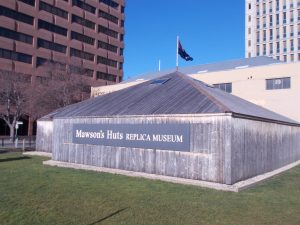The ALSA team outside the Institute for Marine and Antarctic Studies next to a bust of Roald Amundsen, first man at the South Pole
Over 5-7 July the Antarctic Legacy of South Africa’s John Cooper, Anché Louw and Ria Olivier attended the “Depths and Surfaces: Understanding the Antarctic Region through the Humanities and Social Sciences Conference” in Hobart, Tasmania, Australia.
The three-day biennial conference was organized jointly by the History and the Humanities and Social Sciences (HASSEG) Expert Groups of the Scientific Committee on Antarctic Research (SCAR). It was held in the Institute for Marine and Antarctic Studies (IMAS) of the University of Tasmania, situated on the water’s edge near to Hobart’s historic Salamanca Place.
The ALSA team gave three well-received presentations. In addition Ria Olivier chaired a session entitled “Creativity, Collaboration and Data”. The titles of our talks follow:
John Cooper: The end of an era: sealing at the Prince Edward Islands in the early 20th Century
Anché Louw: Archiving and the way forward
Ria Olivier: Understanding the Antarctic Region through digitized history
The conference was attended by about 80 participants, most of who made a presentation in one of the concurrent sessions. Each day commenced with key note talks in plenary by Sanjay Chaturvedi (Panjab University), Anne Noble (Massey University) and Tim Stephens (University of Sydney). It was convened by Elizabeth Leane of IMAS.

The conference ended with a joint meeting of the two SCAR Expert Groups to discuss future meetings and the groups’ direction and an evening workshop to discuss how best to incorporate humanities and social sciences into large polar research projects.
The next morning the ALSA team joined a “Polar Pathways” walking tour of the many public statues and artworks with an Antarctic connection along Hobart’s waterfront district, led by Lorne Kriwoken of the University of Tasmania. Earlier in the week the opportunity was given to visit the Mawson’s Huts Replica Museum.
Read more about the conference here.
Earlier in the week Anché and Ria attended a number of associated meetings and events in Hobart as listed here:
- Expert workshops of the Australian Research Council-funded project Antarctic Cities and the Global Commons: Rethinking the Gateways. The project is led by researchers from Western Sydney University and the University of Tasmania, in partnership with the Hobart City Council and the Tasmanian Department of State Growth. Cape Town is also an Antarctic Gateway City but is not currently involved with the project
- Launch of the Antarctic Gateway Cities Project in the Lord Mayor’s Court Room, Hobart Town Hall (click here)
- Association of Polar Early Career Scientists (APECS) workshop
- Opening of the art exhibition “whiteout whitenoise” at IMAS featuring the works of Anne Noble.
John Cooper, Antarctic Legacy of South Africa, Department of Botany and Zoology, Stellenbosch University, 13 July 2017






